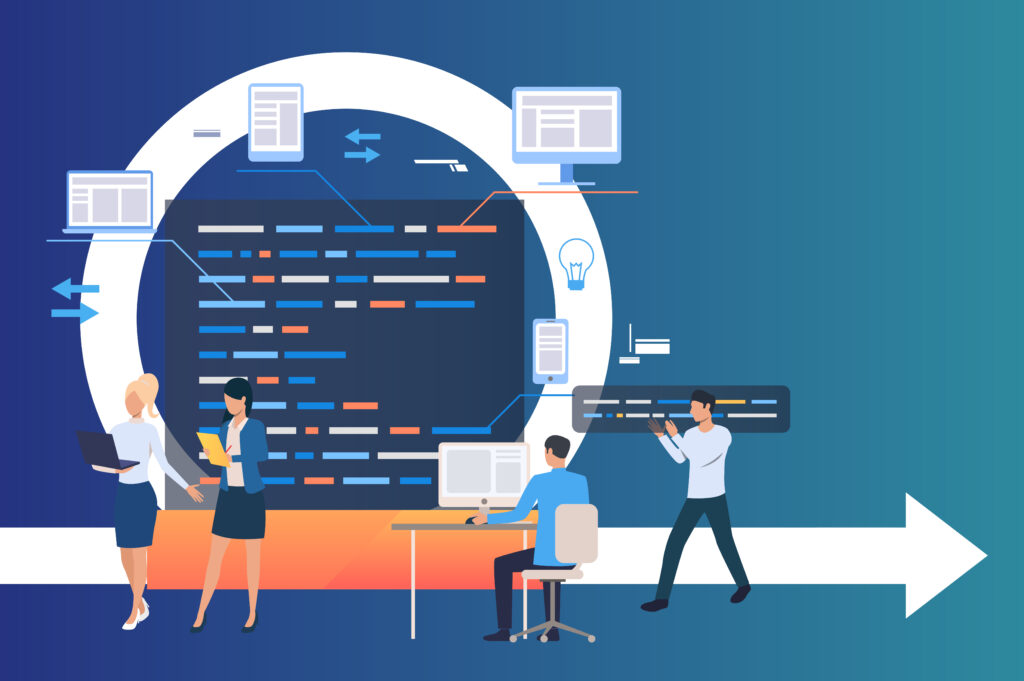Enterprise Performance Management (EPM) Software revolutionizes how businesses analyze data, forecast trends, and optimize operations. From financial consolidation to predictive modeling, EPM software offers robust capabilities for data-driven decision-making. Let’s explore the best EPM options and find the perfect fit for your organization.
What is Enterprise Performance Management (EPM)?
Enterprise Performance Management (EPM) is a strategic approach or framework that helps businesses align their goals with their actions. It’s essentially a toolkit of processes, methods, and technologies used to monitor and manage an organization’s performance. It encompasses:
- Strategic planning and goal setting
- Budgeting and forecasting
- Financial consolidation and reporting
- Operational analytics
- Performance monitoring and measurement
Think of it as a control panel for your business, providing insights into financial performance, operational efficiency, and overall strategic success.
What is EPM Software?
EPM software is a specialized technology solution designed to support and automate Enterprise Performance Management processes. It helps organizations plan, budget, forecast, and report on business performance.
Key features:
- Financial planning and analysis
- Budgeting and forecasting tools
- Scenario modeling capabilities
- Financial consolidation and close management
- Reporting and analytics dashboards
By leveraging EPM software, organizations can make data-driven decisions, improve efficiency, and achieve their strategic objectives.

How does EPM Software work?
EPM software operates by collecting, processing, and analyzing financial data from various sources within an organization. This data includes sales figures, expenses, budgets, forecasts, and key performance indicators (KPIs). Here’s a breakdown of how it typically works:
- Data Collection:
- Integrates with various business systems (ERP, CRM, HR, etc.)
- Collects financial and operational data from across the organization
- Data Consolidation:
- Aggregates data from multiple sources into a centralized database
- Normalizes data for consistency and accuracy
- Analysis and Modeling:
- Applies predefined rules and algorithms to analyze data
- Enables creation of financial and operational models
- Supports scenario planning and what-if analysis
- Planning and Forecasting:
- Facilitates budget creation and financial forecasting
- Allows for collaborative input from various departments
- Performance Monitoring:
- Tracks actual performance against plans and forecasts
- Calculates and displays key performance indicators (KPIs)
- Reporting and Visualization:
- Generates standardized and custom reports
- Presents data through interactive dashboards and visualizations
- Workflow Management:
- Automates approval processes and task assignments
- Ensures data integrity and compliance with business rules
- Continuous Feedback:
- Enables ongoing adjustments to plans based on real-time data
- Supports a cycle of continuous improvement
Throughout these processes, EPM software provides a centralized platform for decision-makers to access, analyze, and act on critical business information.
How does EPM differ from Enterprise Resource Planning (ERP)?
While they are often used together, EPM and ERP serve different purposes within an organization.
- ERP (Enterprise Resource Planning) is the operational backbone, managing core business processes like finance, HR, supply chain, and production. It’s focused on day-to-day operations and transaction processing.
- EPM (Enterprise Performance Management) takes a strategic approach, focusing on planning, budgeting, forecasting, and analyzing performance. It helps organizations make data-driven decisions and achieve their long-term goals.
Essentially, ERP software is about running the business efficiently, while EPM software is about managing and improving the business’s performance.
How do Various Industries Benefit from Custom EPM Software?
Various industries benefit from custom EPM software in different ways, tailored to their specific needs and challenges. Here’s a brief overview:
- Manufacturing: Supply chain optimization, Production capacity planning, Cost management and profitability analysis
- Healthcare: Patient outcome tracking, Resource allocation optimization, and Regulatory compliance management
- Retail: Inventory forecasting, Sales performance analysis, and Customer behavior insights
- Financial Services: Risk management, Regulatory reporting, and Portfolio performance tracking
- Technology: Project profitability analysis, R&D budget allocation, and Product lifecycle management
- Education: Student performance tracking, Resource allocation across departments, and Enrollment forecasting
- Energy: Asset performance management, Demand forecasting, and Regulatory compliance tracking
- Government: Budget planning and control, Performance metrics for public services, Grant management and reporting
Custom EPM software allows these industries to focus on their specific KPIs, regulatory requirements, and strategic objectives, providing tailored insights and planning capabilities.

10 Best Enterprise Process Management (EPM) Software in the Market
Selecting the right EPM software is crucial for organizations looking to upgrade from outdated applications and spreadsheets to a modern solution. The top ten options highlighted here offer unique features and benefits to meet diverse industry needs.
-
Oracle Cloud EPM
- Oracle Cloud EPM is a comprehensive cloud-based solution offering a wide range of EPM functionalities.
- Key Features: Financial consolidation and close, planning and budgeting, profitability and cost management, enterprise data management.
- Pros: Robust and scalable, integrates well with other Oracle products, advanced analytics capabilities.
- Cons: Can be complex to implement, potentially high cost for smaller businesses.
-
SAP Analytics Cloud
- SAP Analytics Cloud combines BI, planning, and predictive analytics in a single SaaS solution.
- Key Features: Integrated planning and analysis, predictive analytics, data visualization, collaborative decision-making.
- Pros: User-friendly interface, strong integration with SAP ERP, machine learning capabilities.
- Cons: Some features may require additional SAP products, can be costly for large deployments.
-
Anaplan
- Anaplan EPM is a cloud-native platform focusing on connected planning across the enterprise.
- Key Features: Collaborative forecasting, scenario planning, real-time modeling, customizable dashboards.
- Pros: Highly flexible, scalable architecture, strong in complex planning scenarios.
- Cons: Steep learning curve for model builders, can be expensive for smaller organizations.
-
Workday Adaptive Planning
- Workday Adaptive Planning EPM offers budgeting, forecasting, and reporting capabilities for businesses of all sizes.
- Key Features: Collaborative planning, reporting and analytics, integration with Workday HCM and Financial Management.
- Pros: User-friendly interface, quick implementation, strong workforce planning capabilities.
- Cons: Some limitations in handling very large data sets, less suitable for complex financial consolidations.
-
IBM Planning Analytics
- IBM Planning Analytics (formerly TM1) provides planning, budgeting, forecasting, and analysis capabilities.
- Key Features: Multidimensional analysis, predictive forecasting, what-if scenario modeling, self-service analytics.
- Pros: Powerful calculation engine, flexible deployment options (cloud or on-premise), strong in complex planning scenarios.
- Cons: Can be complex to set up and maintain, requires specialized skills for advanced use.
-
Prophix
- Prophix is a corporate performance management software that offers budgeting, planning, and reporting solutions.
- Key Features: Financial consolidation, operational planning, cash flow planning, personnel planning.
- Pros: User-friendly interface, strong in mid-market segment, good customer support.
- Cons: Limited advanced analytics capabilities compared to some competitors, less suitable for very large enterprises.
-
Planful (formerly Host Analytics)
- Planful is a cloud-based EPM platform that unifies financial planning, close, and reporting processes.
- Key Features: Financial close management, financial planning and analysis, financial reporting, operational planning.
- Pros: Intuitive user interface, quick implementation, good for mid-sized companies.
- Cons: May lack some advanced features for larger enterprises, limited customization options.
-
OneStream XF
- OneStream XF is a unified platform for financial consolidation, planning, reporting and analysis.
- Key Features: Financial close and consolidation, planning and forecasting, reporting and analytics, data quality management.
- Pros: Highly scalable, robust financial consolidation capabilities, extensible platform.
- Cons: Can be complex to implement, higher price point may not suit smaller organizations.
-
Board
- Board EPM is a decision-making platform that combines business intelligence, planning, and predictive analytics.
- Key Features: Multidimensional analysis, predictive analytics, data discovery and visualization, collaborative planning.
- Pros: Highly flexible, strong in data analysis and visualization, supports both BI and EPM in one platform.
- Cons: Steep learning curve, may require technical expertise for advanced customization.
-
Vena Solutions
- Vena Solutions combines native Excel interface with a centralized database and workflow engine.
- Key Features: Budgeting and forecasting, financial close management, reporting and analytics, Excel-based interface.
- Pros: Familiar Excel interface reduces learning curve, good for finance-led implementations, strong in spreadsheet-centric organizations.
- Cons: May not suit organizations looking to move away from Excel, less advanced in some areas compared to larger vendors.
Disclaimer: Please note that the software landscape is constantly evolving, and new features or updates may have been introduced since the compilation of this list.

What are the Key Features to look for in EPM Software?
Choosing the right EPM software is crucial for your organization’s success. Here are some essential features to consider:
Core EPM Functionalities
- Financial Consolidation: Accurately combine data from multiple sources for a unified view.
- Planning and Budgeting: Create detailed financial plans, budgets, and forecasts.
- Forecasting: Develop predictive models to anticipate future performance.
- Reporting and Analytics: Generate insightful reports and dashboards for decision-making.
- Performance Management: Set KPIs, track performance, and measure against targets.
Advanced Capabilities
- Scenario Planning: Model different business scenarios to assess potential outcomes.
- Driver-Based Planning: Link financial results to underlying drivers for better forecasting.
- Data Integration: Seamlessly connect to other systems (ERP, CRM, HR) for data consolidation.
- Collaboration Tools: Enable real-time collaboration among teams.
- Mobile Access: Provide on-the-go access to data and insights.
- Advanced Analytics: Leverage AI and machine learning for predictive analytics.
- Cloud or On-Premise Deployment: Choose the deployment option that best suits your needs.
Additional Considerations
- User Interface: Ensure the software is intuitive and easy to use.
- Scalability: The software should grow with your business.
- Security: Robust security measures to protect sensitive financial data.
- Implementation Support: Consider the vendor’s implementation services and support.
- Cost: Evaluate the total cost of ownership, including licensing, implementation, and maintenance.
By carefully evaluating these features and your organization’s specific needs, you can select the EPM software that will drive optimal performance and decision-making.
Simplify Your EPM Software Discovery with StaQ.ai
As a comprehensive software marketplace, StaQ.ai simplifies the entire process of researching, evaluating, and purchasing enterprise software like EPM solutions.
With StaQ CoPilot, you can quickly and easily navigate the vast landscape of EPM software options. This all-in-one self-serve platform empowers you and your team to make informed software decisions 10x faster. Simply share your business requirements, and StaQ CoPilot will provide personalized recommendations, pricing insights, and detailed product comparisons to help you find the perfect EPM software fit.
Take the guesswork out of EPM software research – begin your StaQ CoPilot journey today!




